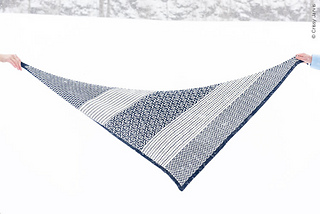patterns > twist collective >  twist collective january 2018
twist collective january 2018
> Yojimbo






Yojimbo
This shawl design was inspired by two things: one, Akira Kurosawa’s film “Yojimbo”, (a personal favorite), and two, a desire to interpret elements of Japanese Sashiko embroidery in knitted color work. Many Sashiko motifs are evocative of natural features such as mountains, mountain trails and still and flowing water. I imagined a thrifty Japanese housewife salvaging useful kimono scraps to make a handy and beautiful wrap to wear on cold, rainy days.
Materials: Valley Yarns Charlemont (439 yd / 401.5 m per 3.5 oz / 100g skein: 60% Fine Superwash Merino, 20% Mulberry Silk, 20% Polyamide): 2 skeins each in #12 Navy Blue (MC) and Natural (CC)
Needles: US size 2 (2.75 mm) circular needle, at least 24 inches (60 cm) long
Notions: Stitch markers, tapestry needle
Yardages used for other yarns:
Handmaiden Fine Yarn Sea Silk: 500 yards MC, 440 CC
Gauge: 31 sts and 42 rows = 4 inches (10 cm) in Stockinette stitch.
This shawl is worked from side-to-side, with increases along one edge to form an elongated triangle. The slip stitch and mosaic patterns are presented in chart form only. Stitch markers placed at uniform intervals will help keep track of the pattern, especially for Chart C.
The border along one edge is worked using intarsia. Each row of the slip stitch and mosaic charts are worked with one color only, with stitches in the second color slipped. Slip all stitches purlwise on both front and back of the work.
The blend of super wash merino, silk and nylon lends a lovely drape to the finished shawl. When choosing colors, be sure to select not only color contrast, but also value contrast to ensure that the embossed designs show up against the background. If one of your colors is a speckle, the second color should be a solid or semisolid. These designs may not look their best with all speckles or with heavily variegated yarns.

- First published: January 2018
- Page created: December 28, 2017
- Last updated: May 31, 2019 …
- visits in the last 24 hours
- visitors right now




